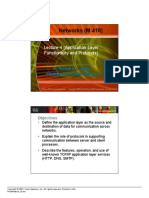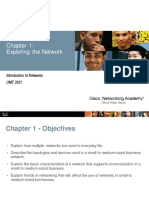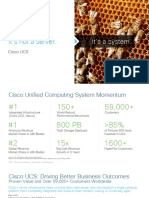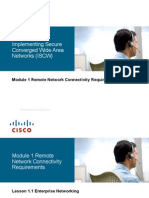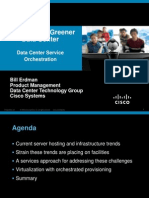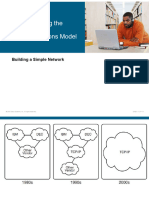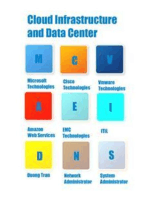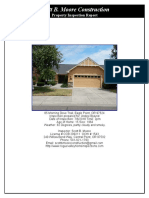Introduction To Enterprise Campus Network Design
Introduction To Enterprise Campus Network Design
Uploaded by
مستر مسترCopyright:
Available Formats
Introduction To Enterprise Campus Network Design
Introduction To Enterprise Campus Network Design
Uploaded by
مستر مسترOriginal Title
Copyright
Available Formats
Share this document
Did you find this document useful?
Is this content inappropriate?
Copyright:
Available Formats
Introduction To Enterprise Campus Network Design
Introduction To Enterprise Campus Network Design
Uploaded by
مستر مسترCopyright:
Available Formats
Introduction to
Enterprise
Campus
Network Design
Chapter #
© 2007 – 2010, Cisco Systems, Inc. All rights reserved. Cisco Public 1
Enterprise Network
Core (Backbone) , Campus, Data Center, Branch,
WAN Internet Edge
Chapter #
© 2007 – 2010, Cisco Systems, Inc. All rights reserved. Cisco Public 2
© 2006, Cisco Systems, Inc. All rights reserved. 1
Presentation_ID.scr
Campus Designs
Modular - easily supports growth and change. Scaling the
network is eased by adding new modules in lieu of
complete redesigns.
Resilient - proper high-availability (HA) characteristics
result in near-100% uptime.
Flexible - change in business is a guarantee for any
enterprise. These changes drive campus network
requirements to adapt quickly.
Chapter #
© 2007 – 2010, Cisco Systems, Inc. All rights reserved. Cisco Public 3
Multilayer Switches in Campus Networks
Hardware-based routing using
Application-Specific Integrated
Circuits (ASICs)
RIP, OSPF, and EIGRP are
supported
Layer 3 switching speeds
approximate that of Layer 2
switches
Layer 4 and Layer 7 switching
supported on some switches
Future: Pure Layer 3
environment leveraging
inexpensive L3 access layer
switches
Chapter #
© 2007 – 2010, Cisco Systems, Inc. All rights reserved. Cisco Public 4
© 2006, Cisco Systems, Inc. All rights reserved. 2
Presentation_ID.scr
Traffic Types
Network Management – BPDU, CDP, SNMP, RMON, SSH
traffic (for example); low bandwidth
IP Telephony – Signaling traffic and encapsulated voice traffic;
low bandwidth
IP Multicast – IP/TV and market data applications; intensive
configuration requirements; very high bandwidth
Normal Data – File and print services, email, Internet browsing,
database access, shared network applications; low to medium
bandwidth
Scavenger Class – All traffic with protocols or patterns that
exceed normal data flows; less than best-effort traffic, such as
peer-to-peer traffic (instant messaging, file sharing, IP phone
calls, video conferencing); medium to high bandwidth
Chapter #
© 2007 – 2010, Cisco Systems, Inc. All rights reserved. Cisco Public 5
Client-Server Applications
Mail servers
File servers
Database servers
Access to applications is
fast, reliable, and secure
Chapter #
© 2007 – 2010, Cisco Systems, Inc. All rights reserved. Cisco Public 6
© 2006, Cisco Systems, Inc. All rights reserved. 3
Presentation_ID.scr
Client-Enterprise Edge Applications
Servers on the enterprise
edge, exchanging data
between an organization
and its public servers
Examples: external mail
servers, e-commerce
servers, and public web
servers
Security and high
availability are paramount
Chapter #
© 2007 – 2010, Cisco Systems, Inc. All rights reserved. Cisco Public 7
Service-Oriented Network Architecture (SONA)
Application Layer – business and collaboration applications; meet business
requirements leveraging interactive services layer.
Interactive Services Layer – enable efficient allocation of resources to
applications and business processes through the networked infrastructure.
Networked Infrastructure Layer – where all IT resources interconnect.
Chapter #
© 2007 – 2010, Cisco Systems, Inc. All rights reserved. Cisco Public 8
© 2006, Cisco Systems, Inc. All rights reserved. 4
Presentation_ID.scr
Borderless Networks
Enterprise architecture launched by Cisco in October 2009.
Model enables businesses to transcend borders, access
resources anywhere, embrace business productivity, and
lower business and IT costs.
Focuses more on growing enterprises into global
companies.
Technical architecture based on three principles:
• Decoupling hardware from software
• Unifying computation, storage, and network
• Policy throughout the unified system
Provides a platform for business innovation.
Serves as the foundation for rich-media communications.
Chapter #
© 2007 – 2010, Cisco Systems, Inc. All rights reserved. Cisco Public 9
Enterprise
Campus Design
Chapter #
© 2007 – 2010, Cisco Systems, Inc. All rights reserved. Cisco Public 10
© 2006, Cisco Systems, Inc. All rights reserved. 5
Presentation_ID.scr
Building Access, Building Distribution, and Building
Core Layers
Building Core Layer: high-
speed campus backbone
designed to switch packets as
fast as possible; provides high
availability and adapts quickly to
changes.
Building Distribution Layer:
aggregate wiring closets and
use switches to segment
workgroups and isolate network
problems.
Building Access Layer: grant
user access to network devices.
Chapter #
© 2007 – 2010, Cisco Systems, Inc. All rights reserved. Cisco Public 11
Core Layer
Aggregates distribution layer switches.
Implements scalable protocols and technologies and load
balancing.
High-speed layer 3 switching using 10-Gigabit Ethernet.
Uses redundant L3 links.
Chapter #
© 2007 – 2010, Cisco Systems, Inc. All rights reserved. Cisco Public 12
© 2006, Cisco Systems, Inc. All rights reserved. 6
Presentation_ID.scr
Distribution Layer
High availability, fast path recovery, load balancing, QoS, and security
Route summarization and packet manipulation
Redistribution point between routing domains
Packet filtering and policy routing to implement policy-based connectivity
Terminate VLANs
First Hop Redundancy Protocol
Chapter #
© 2007 – 2010, Cisco Systems, Inc. All rights reserved. Cisco Public 13
Access Layer
High availability – supported by many hardware and software features, such
as redundant power supplies and First Hop Redundancy Protocols (FHRP).
Convergence – provides inline Power over Ethernet (PoE) to support IP
telephony and wireless access points.
Security – includes port security, DHCP snooping, Dynamic ARP inspection, IP
source guard.
Chapter #
© 2007 – 2010, Cisco Systems, Inc. All rights reserved. Cisco Public 14
© 2006, Cisco Systems, Inc. All rights reserved. 7
Presentation_ID.scr
Small Campus Network
<200 end devices
Collapsed core
Catalyst 3560 and 2960G switches for access layer
Cisco 1900 and 2900 routers to interconnect branch/WAN
Chapter #
© 2007 – 2010, Cisco Systems, Inc. All rights reserved. Cisco Public 15
Medium Campus Network
200-1000 end devices
Redundant multilayer switches at distribution layer
Catalyst 4500 or 6500 switches
Chapter #
© 2007 – 2010, Cisco Systems, Inc. All rights reserved. Cisco Public 16
© 2006, Cisco Systems, Inc. All rights reserved. 8
Presentation_ID.scr
Large Campus Network
>2000 end users
Stricter adherence to core, distribution, access delineation
Catalyst 6500 switches in core and distribution layers
Nexus 7000 switches in data centers
Division of labor amongst network engineers
Chapter #
© 2007 – 2010, Cisco Systems, Inc. All rights reserved. Cisco Public 17
Data Center Infrastructure
Core layer – high-speed packet switching backplane
Aggregation layer – service module integration, default gateway
redundancy, security, load balancing, content switching, firewall, SSL
offload, intrusion detection, network analysis
Access layer – connects servers to network
Chapter #
© 2007 – 2010, Cisco Systems, Inc. All rights reserved. Cisco Public 18
© 2006, Cisco Systems, Inc. All rights reserved. 9
Presentation_ID.scr
PPDIOO Lifecycle
Approach to
Network Design
and
Implementation
Chapter #
© 2007 – 2010, Cisco Systems, Inc. All rights reserved. Cisco Public 19
PPDIOO Phases
Prepare – establish organizational requirements.
Plan – identify initial network requirements.
Design – comprehensive, based on planning outcomes.
Implement – build network according to design.
Operate – maintain network health.
Optimize – proactive management of network.
Chapter #
© 2007 – 2010, Cisco Systems, Inc. All rights reserved. Cisco Public 20
© 2006, Cisco Systems, Inc. All rights reserved. 10
Presentation_ID.scr
Lifecycle Approach (1)
Benefits:
• Lowering the total cost of network ownership
• Increasing network availability
• Improving business agility
• Speeding access to applications and services
Lower costs:
• Identify and validate technology requirements
• Plan for infrastructure changes and resource requirements
• Develop a sound network design aligned with technical requirements
and business goals
• Accelerate successful implementation
• Improve the efficiency of your network and of the staff supporting it
• Reduce operating expenses by improving the efficiency of operational
processes and tools
Chapter #
© 2007 – 2010, Cisco Systems, Inc. All rights reserved. Cisco Public 21
Lifecycle Approach (2)
Improve high availability:
• Assessing the network’s security state and its capability to support the proposed design
• Specifying the correct set of hardware and software releases, and keeping them operational and current
• Producing a sound operations design and validating network operations
• Staging and testing the proposed system before deployment
• Improving staff skills
• Proactively monitoring the system and assessing availability trends and alerts
Gain business agility:
• Establishing business requirements and technology strategies
• Readying sites to support the system that you want to implement
• Integrating technical requirements and business goals into a detailed design and demonstrating
• that the network is functioning as specified
• Expertly installing, configuring, and integrating system components
• Continually enhancing performance
Accelerate access to network applications and services:
• Assessing and improving operational preparedness to support current and planned network technologies
and services
• Improving service-delivery efficiency and effectiveness by increasing availability, resource capacity, and
performance
• Improving the availability, reliability, and stability of the network and the applications running on it
• Managing and resolving problems affecting your system and keeping software applications current
Chapter #
© 2007 – 2010, Cisco Systems, Inc. All rights reserved. Cisco Public 22
© 2006, Cisco Systems, Inc. All rights reserved. 11
Presentation_ID.scr
Planning a Network Implementation
Implementation Components:
• Description of the step
• Reference to design documents
• Detailed implementation guidelines
• Detailed roll-back guidelines in case of failure
• Estimated time needed for implementation
Summary Implementation Plan – overview of
implementation plan
Detailed Implementation Plan – describes exact steps
necessary to complete the implementation phase, including
steps to verify and check the work of the network engineers
implementing the plan
Chapter #
© 2007 – 2010, Cisco Systems, Inc. All rights reserved. Cisco Public 23
© 2006, Cisco Systems, Inc. All rights reserved. 12
Presentation_ID.scr
You might also like
- Construction Productivity NormsDocument1 pageConstruction Productivity NormsDilip Kumar100% (1)
- Learning SD-WAN with Cisco: Transform Your Existing WAN Into a Cost-effective NetworkFrom EverandLearning SD-WAN with Cisco: Transform Your Existing WAN Into a Cost-effective NetworkNo ratings yet
- Chapter 10: Network Design: Introduction To NetworkingDocument42 pagesChapter 10: Network Design: Introduction To NetworkingPhillipNo ratings yet
- Network Management and Administration-NotesDocument11 pagesNetwork Management and Administration-NotesSalman Ilyas Awan71% (7)
- CCNA 2 - Chapter 1 - Routing Switching - Introduction To Switched NetworksDocument30 pagesCCNA 2 - Chapter 1 - Routing Switching - Introduction To Switched Networksexample xxNo ratings yet
- Analyzing The Cisco Enterprise Campus Architecture: CCNP SWITCH: Implementing IP SwitchingDocument33 pagesAnalyzing The Cisco Enterprise Campus Architecture: CCNP SWITCH: Implementing IP SwitchingYiannis NeocleousNo ratings yet
- SW Ch01Document33 pagesSW Ch01Fabio QuintanaNo ratings yet
- CCNP Switch Ch01Document33 pagesCCNP Switch Ch01Latanya Beard100% (1)
- Network - Lecture 5 (Presentation-Session&Transport Layer)Document10 pagesNetwork - Lecture 5 (Presentation-Session&Transport Layer)alcinialbob1234No ratings yet
- Networks (M 418)Document27 pagesNetworks (M 418)Menna El DaLyNo ratings yet
- Ccna5 - rs5.0 Chapter2 Connecting To WANsDocument43 pagesCcna5 - rs5.0 Chapter2 Connecting To WANsGabe SingsonNo ratings yet
- CN418 Application 4RDocument17 pagesCN418 Application 4RMenna El DaLyNo ratings yet
- Planning Routing Services To RequirementsDocument60 pagesPlanning Routing Services To Requirementskirakun277No ratings yet
- Routing Services: CCNP ROUTE: Implementing IP RoutingDocument72 pagesRouting Services: CCNP ROUTE: Implementing IP RoutingLê Ngọc DũngNo ratings yet
- Chapter 1: Introduction To Switched Networks: Routing and SwitchingDocument28 pagesChapter 1: Introduction To Switched Networks: Routing and SwitchingTsehayou SieleyNo ratings yet
- En Route v6 Ch07Document180 pagesEn Route v6 Ch07Ivan NuñezNo ratings yet
- Unidad4v1 4Document19 pagesUnidad4v1 4Andres SanchezNo ratings yet
- Chapter 1: Introduction To Scaling NetworksDocument35 pagesChapter 1: Introduction To Scaling NetworksphilNo ratings yet
- Validated Network Architectures For Midsize OrganizationsDocument34 pagesValidated Network Architectures For Midsize Organizationsfreealex100% (1)
- Chapter1 - Exploring The Network-PDFSlideDocument32 pagesChapter1 - Exploring The Network-PDFSlideLim Soong XIanNo ratings yet
- CCNP ROUTE Ch01Document71 pagesCCNP ROUTE Ch01kupeoNo ratings yet
- Implementing Routing Facilities For Branch Offices and Mobile WorkersDocument180 pagesImplementing Routing Facilities For Branch Offices and Mobile WorkersAlejandro Cordero OrdoñezNo ratings yet
- Cisco UCS Servers PresentationDocument13 pagesCisco UCS Servers PresentationElvis Frank Camacho VillegasNo ratings yet
- Building Core Networks With OSPF, Is-Is, BGP, and MPLSDocument252 pagesBuilding Core Networks With OSPF, Is-Is, BGP, and MPLSWeiborao100% (1)
- Network - Lecture 6 (Network Layer)Document10 pagesNetwork - Lecture 6 (Network Layer)alcinialbob1234No ratings yet
- ITN6 Instructor Materials Chapter1Document26 pagesITN6 Instructor Materials Chapter1abdirazakiman97No ratings yet
- Network Design Fundamentals: CCNP SWITCH: Implementing Cisco IP Switched NetworksDocument41 pagesNetwork Design Fundamentals: CCNP SWITCH: Implementing Cisco IP Switched NetworksSulayman AlwabelNo ratings yet
- Network Design Fundamentals: CCNP SWITCH: Implementing Cisco IP Switched NetworksDocument41 pagesNetwork Design Fundamentals: CCNP SWITCH: Implementing Cisco IP Switched NetworkszizozoroNo ratings yet
- ITN - Module - 1 - OkDocument35 pagesITN - Module - 1 - Okdarriia12No ratings yet
- Lesson 1 - Enterprise NetworkingDocument16 pagesLesson 1 - Enterprise NetworkingPubli Guia TarijaNo ratings yet
- WINSEM2022-23 CSE3502 ETH VL2022230503110 2022-12-12 Reference-Material-IDocument24 pagesWINSEM2022-23 CSE3502 ETH VL2022230503110 2022-12-12 Reference-Material-Ipadm kesavNo ratings yet
- Ethernet I/P Best Practices & TopologiesDocument68 pagesEthernet I/P Best Practices & TopologiesmeledathNo ratings yet
- IOS-XR Users and Groups Inside LinuxDocument5 pagesIOS-XR Users and Groups Inside LinuxKonstantinos DimitriouNo ratings yet
- V8: Net-Ing A Greener Data CenterDocument24 pagesV8: Net-Ing A Greener Data CenterAnonymous kbmKQLe0JNo ratings yet
- ONT Mod 1 Lesson 2Document24 pagesONT Mod 1 Lesson 2Yousuf AlowidiNo ratings yet
- Exploration Network Chapter1Document25 pagesExploration Network Chapter1Sabari NathanNo ratings yet
- Chapter 5 - Build A Small NetworkDocument49 pagesChapter 5 - Build A Small Networkamin1240100% (1)
- CCNA3 CH 1Document18 pagesCCNA3 CH 1Mohammed ElaydiNo ratings yet
- Lecture 3 - Networking Today Network 1Document52 pagesLecture 3 - Networking Today Network 1mohamed ghnamNo ratings yet
- Xrdocs IoDocument5 pagesXrdocs IoMohamedNo ratings yet
- ACCS-chapter 1 - Part-1Document19 pagesACCS-chapter 1 - Part-1ealabaseNo ratings yet
- Chapter 11: Build A Small Network: CCNA Routing and Switching Introduction To Networks v6.0Document55 pagesChapter 11: Build A Small Network: CCNA Routing and Switching Introduction To Networks v6.0Nehal GuptaNo ratings yet
- Lecure#1 - FundamentalsDocument43 pagesLecure#1 - FundamentalsTahmid Kabir AddinNo ratings yet
- Tuan02 3Document23 pagesTuan02 3ohong.181278No ratings yet
- Network design Chap-3 Modular approach in network designDocument6 pagesNetwork design Chap-3 Modular approach in network designmeazamilkiassNo ratings yet
- CCNP Iscw Chapter 1Document22 pagesCCNP Iscw Chapter 1aresbuddyNo ratings yet
- Chapter 1: Introduction To Switched Networks: Routing and SwitchingDocument43 pagesChapter 1: Introduction To Switched Networks: Routing and SwitchingKhairi AzamNo ratings yet
- CH 1 - Session1&2Document42 pagesCH 1 - Session1&2Ali TarhiniNo ratings yet
- K Avian Pour 2017Document4 pagesK Avian Pour 2017Adeel TahirNo ratings yet
- Notes Automatic ComputingDocument58 pagesNotes Automatic ComputingPuneetShahNo ratings yet
- Cisco Certified Network Associate (200-301 CCNA)Document111 pagesCisco Certified Network Associate (200-301 CCNA)هويدتي اناNo ratings yet
- IoT Material 4Document26 pagesIoT Material 4venkadjegaNo ratings yet
- Networking: Cisco IOSDocument47 pagesNetworking: Cisco IOSkardeslerim123No ratings yet
- CN instructorPPT Chapter1 FinalDocument31 pagesCN instructorPPT Chapter1 FinalArbias GashiNo ratings yet
- Configuring IPCop Firewalls: Closing Borders with Open Source: How to setup, configure and manage your Linux firewall, web proxy, DHCP, DNS, time server, and VPN with this powerful Open Source solutionFrom EverandConfiguring IPCop Firewalls: Closing Borders with Open Source: How to setup, configure and manage your Linux firewall, web proxy, DHCP, DNS, time server, and VPN with this powerful Open Source solutionNo ratings yet
- Designing and Implementing Linux Firewalls and QoS using netfilter, iproute2, NAT and l7-filterFrom EverandDesigning and Implementing Linux Firewalls and QoS using netfilter, iproute2, NAT and l7-filterNo ratings yet
- Software Defined Networking (SDN) - a definitive guideFrom EverandSoftware Defined Networking (SDN) - a definitive guideRating: 2 out of 5 stars2/5 (2)
- Fire Bricks: Physical and Chemical PropertiesDocument11 pagesFire Bricks: Physical and Chemical PropertiesRajeshwareesawant100% (1)
- Desktop Study 3 (International)Document7 pagesDesktop Study 3 (International)idrees aliNo ratings yet
- New Text DocumentDocument13 pagesNew Text DocumentJitendra Karn RajputNo ratings yet
- Realization of IEC 60870-5-104 Protocol in DTUDocument6 pagesRealization of IEC 60870-5-104 Protocol in DTUKalyan RanjanNo ratings yet
- By David J Hammond S.E. and Paul Decicco P.E.: Nfpa Fire Protection Manual 2003 Sect 12, CH 11Document13 pagesBy David J Hammond S.E. and Paul Decicco P.E.: Nfpa Fire Protection Manual 2003 Sect 12, CH 11fraantoineNo ratings yet
- Integration of Ldap With SambaDocument13 pagesIntegration of Ldap With SambaJaiyachitra JayachandranNo ratings yet
- Construction ProfessionalsDocument8 pagesConstruction ProfessionalschristopherNo ratings yet
- CatalogDocument49 pagesCatalogBrad GormanNo ratings yet
- Stegbar AluminiumDocument28 pagesStegbar Aluminiummike_ole02No ratings yet
- Home Inspection 85 Morning DoveDocument59 pagesHome Inspection 85 Morning DoveAnonymous 1cRF2j7G9No ratings yet
- Itecompsysl Activity 3 ReportDocument6 pagesItecompsysl Activity 3 ReportJulian Miguel N. AdiqueNo ratings yet
- APT Shoring Drawings From Various ProjectDocument15 pagesAPT Shoring Drawings From Various ProjectBinSayeedNo ratings yet
- Cement ConsumptionDocument2 pagesCement ConsumptionAliasgar LokhandwalaNo ratings yet
- An Arch Is A Structure Constructed of Wedge-Shaped UnitDocument28 pagesAn Arch Is A Structure Constructed of Wedge-Shaped UnitRohit KhannaNo ratings yet
- Fly Ash Building BricksDocument12 pagesFly Ash Building BricksAnonymous g1LSaA100% (1)
- Al Mazloum Heritage Project 2012Document117 pagesAl Mazloum Heritage Project 2012TerriPlez100% (1)
- Mobile Agent-Based Applications: A Survey: Abdelkader OuttagartsDocument9 pagesMobile Agent-Based Applications: A Survey: Abdelkader OuttagartsMuzamil Hussain MariNo ratings yet
- Davis Fontes68 PDFDocument107 pagesDavis Fontes68 PDFMarius TichescuNo ratings yet
- Blast Loading On StructureDocument140 pagesBlast Loading On StructureMahesh OzardeNo ratings yet
- TFR1 Precast RCDocument19 pagesTFR1 Precast RCvaibhavsenses100% (1)
- (2014) ERV PLUS For DVM S - VER01 - 140107 PDFDocument36 pages(2014) ERV PLUS For DVM S - VER01 - 140107 PDFDimas adi putraNo ratings yet
- Fatima CVDocument1 pageFatima CVAhmed eprahiemNo ratings yet
- Aços Chapas e PerfisDocument1 pageAços Chapas e PerfisGenilsonNo ratings yet
- SolarReflectance Stainless SteelDocument3 pagesSolarReflectance Stainless SteelNurCholisNo ratings yet
- UART ArchitectureDocument23 pagesUART ArchitectureEdgar Mugabi Tusuubira100% (4)
- Introduction Marasigan StoryDocument7 pagesIntroduction Marasigan StoryJennina Santi Codog ValduezaNo ratings yet
- SMD Question BankDocument2 pagesSMD Question BankBharatNo ratings yet
- 5 Pidicrete URPDocument4 pages5 Pidicrete URPK Sri KarthikNo ratings yet
- Design of Reinforced Concrete Shear WallDocument15 pagesDesign of Reinforced Concrete Shear WallAnonymous nwByj9L0% (1)











